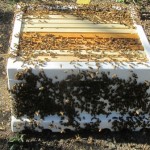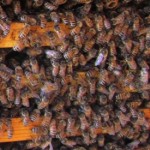Swarms of Honeybees Mark an Early Start to Spring
On my birthday in late March this year, I noticed a large swarm of honeybees in my neighbor’s yard. The weather was warm and perfect for the overpopulated hive to release some of its citizens to find a new home with their new fertile queen.
Then on April 8–Easter Sunday, my own Italian honeybees swarmed. Our hive had made it through the winter although the bees had battled hive beetles. But just as hubby and I were on ladders that Easter afternoon building a new trellis for our grapes, I heard the low hum of thousands of bees lifting skyward.
Sure enough, the new swarm had emerged from our hive. We dropped our drills, screws, and lumber. He banged on cooking pot with a wooden spoon (to disorient the bees and encourage them to land in a nearby tree) while I set up the extra hive box with empty frames.
Suited up in beekeeper gear, my hubby clipped a couple of branches from the pin oak tree to make it possible to do a hard shake on the one limb the bees had coalesced around. He placed the prepared hive box beneath the tree. Our beekeeper neighbor joined us and helped. Then, a hard shake and boom…the entire colony dropped into the hive box.
We waited until after dark to ease the hive box lid in place and then take the entire box to its permanent location in a sunny, dry spot in the garden.

A hive box without its lid. The bees do a waggle dance to tell the bees still in the air that this is their new home
The work on the trellis that will serve as our grape arbor was nearly complete when the swarm occurred. Now the finishing touches will have to wait for another day.
Helping a Kitchen Garden to Grow in Clay Soil
Under the searing summer sun, the clay soil of my farmette will grow amazing pin oaks, white oaks, and pine trees. But for a gardener like me who wants to grow vegetables and herbs, clay soil frustrates and challenges.
Before planting next year’s kitchen garden in a new area of the property, I’ll have to change the soil structure now. This will take time and a lot of effort, but it will pay huge dividends over the long term.
Here are a few things things a gardener can do to improve clay soil.
1. A few weeks before working an area, mulch the area with an eight to ten-inch layer of wood chips to help the soil retain moisture and regain structure.
2. Use a pickax to break up the soil to the depth of 10 inches and work in composted organic material.
3. Avoid working the soil after a rain or when the ground is wet because the soil will ball up into unwieldy clumps.
4. Work in sand or perlite to create more pore space for aeration and drainage. Beware of adding too much sand; the soil becomes like concrete. Ideally, the soil should have roughly fifty percent pore space with minerals and organic matter filling in the rest.
5. When not growing plants, sow a cover crop of legumes to reduce weed germination, prevent erosion, and help water penetrate deeply into the soil. A legume cover crop provides plant matter that can be turned back into the soil or mowed, leaving the plant’s bio mass in place. Legumes fix the nitrogen in the soil that will nourish the plants of the kitchen garden.
6. Repeat all of the above steps annually and dig, turn, rake, and water. Over time, the soil should support healthy roots of plants and give you a robust kitchen garden that will provide many tasty vegetables and culinary herbs.
____________________________________________________________________
If you enjoy reading cozy mysteries and are interested in gardening/farming topics, keeping bees and chickens, or creating delicious recipes from heirloom vegetables and herbs, check out my Henny Penny Farmette series. All are available from Amazon, Barnes and Noble, and other traditional and online bookstores everywhere.
Coming 9/27/17
PUBLISHERS WEEKLY 08/14/2017 noted:
“Lester’s sensitive portrayal of Abby’s struggle with her wounded psyche raises this traditional mystery above the pack.”
See more at: https://www.barnesandnoble.com/w/a-hive-of-homicides-meera-lester/1125424538?type=eBook
 Facebook
Facebook Goodreads
Goodreads LinkedIn
LinkedIn Meera Lester
Meera Lester Twitter
Twitter









